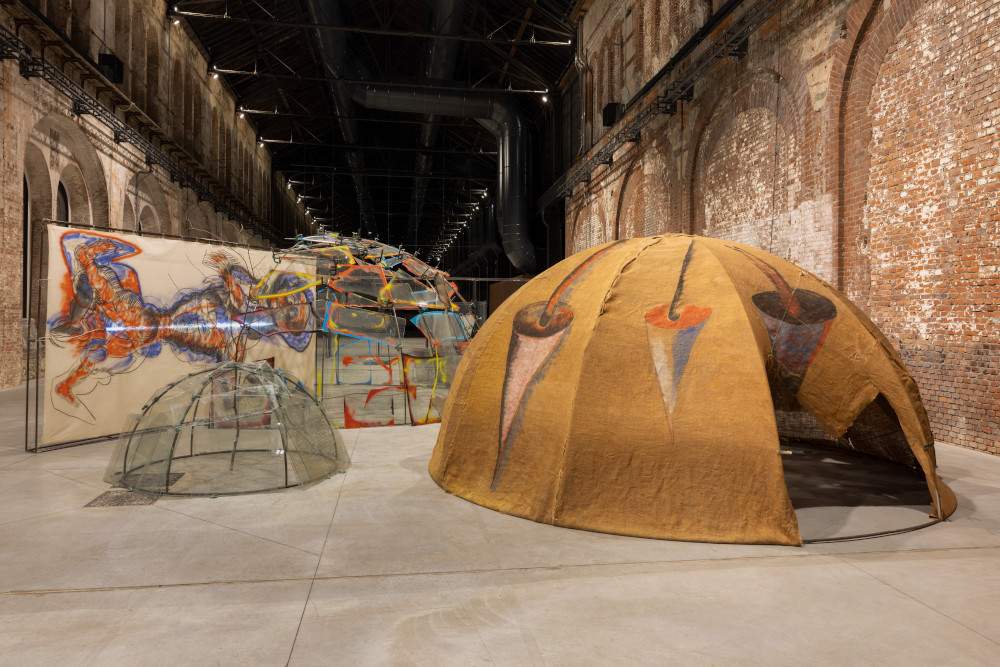OGR Turin, an exhibition traces the theme of art and nature from Arte Povera to today
From April 29 to September 22, 2022 OGR Turin in collaboration with Castello di Rivoli Museo d’Arte Contemporanea presents the exhibition Naturecultures. Art and Nature from Arte Povera to Today. From the Collections of the Fondazione per l’Arte Moderna e Contemporanea CRT at the Castello di Rivoli, curated by Carolyn Christov-Bakargiev, Marcella Beccaria and Samuele Piazza, staged at OGR Turin’s Binario 1 and 2, organized by OGR Turin and Castello di Rivoli Museo d’Arte Contemporanea with the extraordinary contribution of the Fondazione CRT and the support of the Fondazione per l’Arte Moderna e Contemporanea CRT.
The exhibition displays works mostly from the collection of Fondazione per l’Arte Moderna e Contemporanea CRT, acquired between 2000 and 2021 thanks to Fondazione CRT. Works created by Mario Merz, Marisa Merz, Michelangelo Pistoletto, Giovanni Anselmo , Jannis Kounellis, Piero Gilardi, Pier Paolo Calzolari, Gilberto Zorio, Richard Long, Giuseppe Penone, Amar Kanwar, and Agnieszka Kurant.
"With Naturecultures, OGR Torino and Fondazione CRT consolidate their commitment to the development of unprecedented projects, capable of strengthening ties with institutions of excellence in the area and contributing to the creation of social value,“ says Massimo Lapucci, CEO of OGR Torino and Secretary General of Fondazione CRT. ”Starting with the display of a selection of works created from the 1960s to the present day, and acquired over the past two decades thanks to Fondazione CRT, the exhibition emphasizes the special focus on pivotal contemporary issues, in line with the points of Agenda 2030. From climate change to sustainable development, to the broader discourse on ecology, through artistic research we create opportunities for encounters and open spaces for dialogue, with the aim of engaging an increasingly broad audience and fostering awareness and collective reflection on the challenges of the present."
“From the knots in the wood you can see which way the tree towered in the sky, which way it absorbed the light of the south, whether born in a crowded forest, in a meadow or at the edge of the woods,” wrote Giuseppe Penone in 1970, shortly after he began in 1969 to create his most iconic works by carving and digging around the visible knots in the wood of industrial beams to bring out the trunk and branches of the tree at a younger age. With his gestures, the artist reversed the process of industrialization of materials, finding ’natural’ forms (the tree) at the heart of standardized forms (the beams). Arte povera artists investigated the reality of physical experience; they used elementary techniques and common materials to overcome the separation between nature and artifice and to make perceptible a bodily awareness of the sensible world.
Thirty years later, since the late 1990s, climate change caused by the exploitation of energy resources and the resulting global warming have changed the world. Artists globally became documentary filmmakers and activists in the 2000s, exposing social and environmental crimes.
Among the masterpieces on display are Michelangelo Pistoletto’s Venus of Rags (1967), a cult work of counterculture in the 1960s that anticipated issues of material recycling, and the 11-meterTree (1969-89) by Giuseppe Penone, which reveals the shape of the tree from an industrial beam by sculpting around the knots, to Amar Kanwar’s The Sovereign Forest (2012), which denounces forms of climatic and social injustice, and a new algorithm-generated alphabet in Agnieszka Kurant’s Adjacent Possible (2021), created with bacterial pigments.
“In even more recent times, in the second decade of the new century,” said Carolyn Christov-Bakargiev, director of the Castello di Rivoli Museum of Contemporary Art, "everyday digital life has moved us away from the experience of the continuity between nature and culture, leading us toward an experience in which, perhaps for the first time since the Enlightenment, the body (nature) and the mind (the algorithm, the digital) are mistakenly perceived as separate. In this perspective, nature becomes thematized by young digital natives. But melancholy with respect to ecological catastrophe is simultaneously transformed by modern-day artists into a new alliance naturecultures, a term coined by scholar Donna Haraway, in which the algorithm could be used not only by thepredictive statistics of contemporary consumerism, but also to find new possible worlds and synergies that unite the biological and the numerical, as in Agnieszka Kurant’s Adjacent Possibleworks, exhibited for the first time at Castello di Rivoli in 2021."
From May to September, a rich program of collateral events curated by the Castello di Rivoli, in collaboration with the Fondazione per l’Arte Moderna e Contemporanea CRT, will allow the public to explore the exhibition’s themes, such as the relationship between art and ecology, biodiversity, the birth of Arte Povera, and the new frontiers of collecting. Scheduled are guided tours with the exhibition curators, talks, excursions, and the international Climate PTSD conference featuring experts from around the world who will discuss the post-traumatic effects of climate change.
For more info: www.ogrtorino.it
Photo by Andrea Rossetti
 |
| OGR Turin, an exhibition traces the theme of art and nature from Arte Povera to today |
Warning: the translation into English of the original Italian article was created using automatic tools. We undertake to review all articles, but we do not guarantee the total absence of inaccuracies in the translation due to the program. You can find the original by clicking on the ITA button. If you find any mistake,please contact us.




























